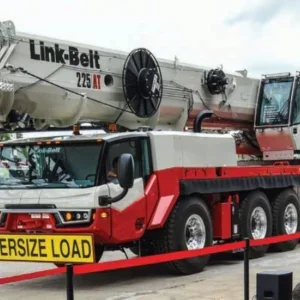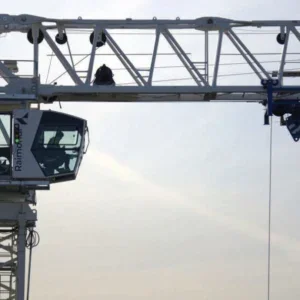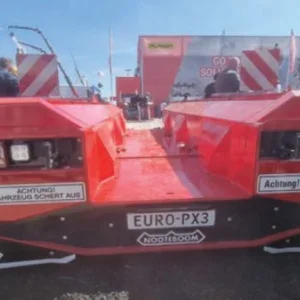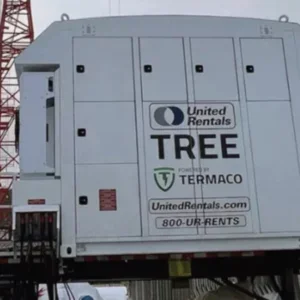
What have been the biggest engineering challenges in developing the GMK5150XLe and GMK5150L-1e?
When we revealed the GMK4100L-2 in late 2022 it was just a concept, so to advance that to a serial production machine required a lot of intense design and testing.
We are actually unveiling a bigger machine than our concept and in two versions: the GMK5150XLe and the GMK5150L-1e. These machines have completed extensive testing to assure the high reliability levels that our customers expect. The cranes also have a more sophisticated design than the concept GMK4100L-2 we showed at Bauma 2022.
We have adapted and optimised our assembly processes to produce the new cranes, and we’ve put in place all the necessary measures to ensure full service and parts for customers.
As always, some of the most challenging aspects were in the finer details of the crane. For example, we developed a ‘mature’ battery management system with heating and air conditioning conducted by a super-efficient heat pump.
And to make the operation of our new hybrids as easy as possible, we also integrated a generator into the driveline to allow charging while driving.
These might not sound like major challenges, but they actually take a lot of fine-tuning – to precisely program when the battery needs to charge and how much. And the result is a success – an extremely efficient drivetrain which allows great flexibility in charging.
What prompted the upgrade from four axles, as seen on the concept, to five axles as seen on the debut models?
There was a hugely positive reaction to the concept GMK4100L-2 hybrid at Bauma 2022. We spoke with many customers from around the world who were keen to make the concept a reality. These discussions also showed us that there was greatest demand for a machine in the 150 tonne category.
The Voice of the Customer process is an integral part of our new product development and so naturally our discussions informed the next stages of development.
There are numerous factors which make the GMK5150L-1e and the GMK5150XLe the perfect size for this exciting electrification project
How do these plug-in hybrid cranes differentiate themselves from the competition?
We can’t comment on what other manufacturers are doing. Our motivation for this project is the needs of our customers, driven through our Voice of the Customer process. We certainly believe we have the best overall hybrid crane solution.
We say this because we offer the flexibility to charge the battery pack either from the grid (with either AC or DC supplies) or through the built-in generator, removing any concerns customers have about charging infrastructure.
So if there is no charging infrastructure at the customer’s depot or on the jobsite, the journey to and from the project can still be used to recharge the 180 kWh battery pack.
The battery pack can accommodate a full working day without any compromises in performance. Even if the crane handles several jobs a day, recharging is unlikely to be required at the jobsite. And if grid charging is available at the jobsite, the crane can operate while being charged.
What are the key differentials between the two models? Are they suited to similar or different applications?
The difference between the two hybrid models are the same as for the traditional diesel-powered equivalents.
So the only differences are in boom and jib length and the hybrid cranes will generally work in the same applications as the diesel models, but then they will also be able to serve environmentally-sensitive jobsites, or projects where noise levels or vehicle emissions need to be restricted, such as in city centres.
Where, globally, will they be available and where do you expect take-up to be greatest?
The cranes are being made available in all global markets. But we also see some key markets for these cranes, where there is a stronger focus on low emission cranes.
What applications do you expect the cranes to be used for?
There is obviously strong potential for them to operate as taxi cranes, handling a variety of tasks. The 150 tonne class of cranes serves all kinds of applications, from the erection of small tower cranes to satellite dish installations to general construction or installing HVAC systems on high-rise buildings.
The cranes can also work in industrial settings, such as refineries or chemical plants. The GMK5150L-1e and GMK5150XLe fit perfectly wherever compactness and reach are needed.
And then with their zero-emissions operations, the cranes are also able to take on environmentally-sensitive jobs or work where lower emissions or noise levels are important.
How long does it take to fully charge the battery using the different charging options?
When connected to a DC fast charger it takes around an hour to reach a full state of charge. If the internal generator is being used for charging it also takes around an hour to get to 100% charge. We should also note that the crane’s diesel engine can also be run on HVO fuel, which offers CO2 emissions reductions of up to 90% compared with traditional diesel fuels.
When connected to 400V/32A power supply, the battery pack can charge overnight and be at 100% by the next morning. The crane can also work while charging with no impact on performance. With a full battery pack and if connected to the grid with a 32A supply, the crane can work for around 20 hours emissions-free. This kind of performance ensures the crane can handle all tasks in a day on even the most demanding jobsites.
What is the expected on-board battery lifespan? And how does maintenance compare to traditional diesel models?
The expected lifespan is comparable to modern electric cars, so even after ten years, the capacity should still be above 80% which is still a high level.
In terms of maintenance, customers can expect to make savings as the diesel engine will not run as much as on a conventional crane as the idling phases can be eliminated which increases overall lifespan.
Where on the chassis is the battery system located? Do the batteries comprise part of the counterweight system?
The batteries are located on the superstructure. But the density of cast iron is much higher than that of batteries, so it’s not a straight swap. We also had to adjust the design to ensure easy access to all components, for example the auxiliary hoist which is needed during rigging.
How future-proof are the cranes? For example, can the batteries be swapped out or upgraded, if ever required?
This is something we spent much time exploring during product development. Unlike the GMK4100L-2 concept, we had to create a serial production crane capable of delivering many years of productive service. We also factored in that the crane will most likely enjoy a second life, and in this phase of its lifespan the hybrid drive may be less important. So that’s why we also ensured it can always run on the internal diesel engine as every other crane does, and without any compromise on performance.
Can the crane operate effectively in extreme weather conditions, such as very cold or hot climates?
This was one of the major questions asked by our customers and it’s certainly something we have factored into the design, not only for operation but also for stowage, start-up, and while driving. We have a heating and air conditioning system which keeps the battery in good condition, and which operates independently of the standard heater and AC. We did this to ensure there is never a conflict in priority between the battery and the operator.
Tell us about crane testing: has it been used on a jobsite yet?
The crane has been undergoing test programmes at several jobsites but the superstructure testing is primarily being done at our own Product Verification Center at our factory in Wilhelmshaven, Germany. The testing has been progressing to plan with excellent results.
How easy will it be for crane operators transitioning to hybrid models? What kind of training or support will be available?
It was important to us and our customers that operating the crane would not require any additional training. So an operator who can run a GMK5150XL can also operate the GMK5150XLe. It’s that simple.
Of course, for the service technicians there needs to be additional training around how to maintain the new electrical, high voltage part of the crane. Understanding this was one of the reasons we decided to only have one electric motor to drive the hydraulic system, so maintaining the hydraulics requires no additional training as the system is the same as on the traditional diesel versions of the crane.
How do these cranes fit into Manitowoc’s long-term strategy for electrification and sustainability?
This is an exciting step forward for our all-terrain crane product line towards greater electrification. There will be more to come in the future.
Have you had any feedback from customers about the new cranes yet or is the debut at Bauma 2025 the first time the industry will see them?
The cranes have their public debut at Bauma, but we are in very close contact with key customers and have demonstrated the cranes to several interested customers. At Manitowoc we believe that customer involvement is the key to successful product development. Understanding customer expectations through our Voice of the Customer programme and implementing the findings into our product development is crucial for us.






